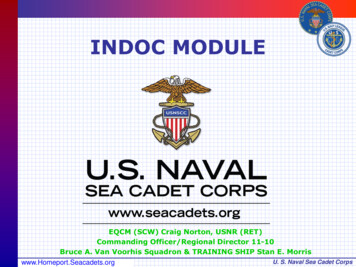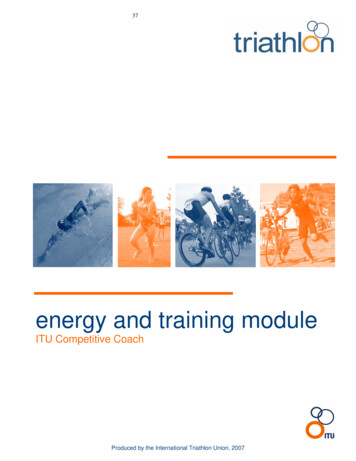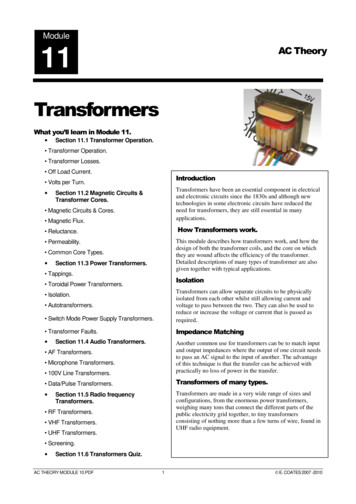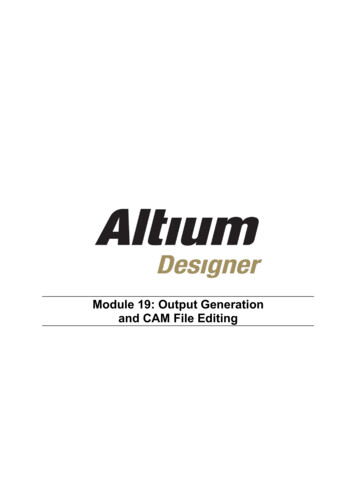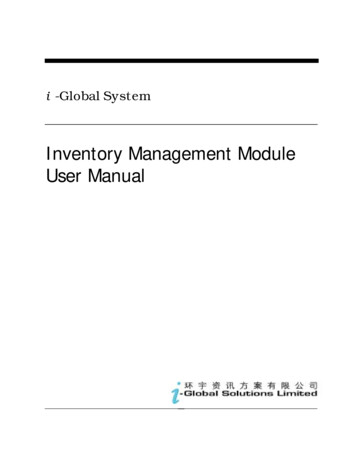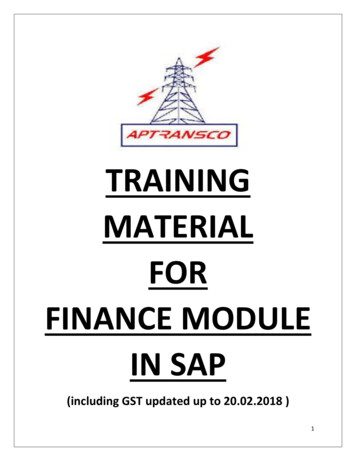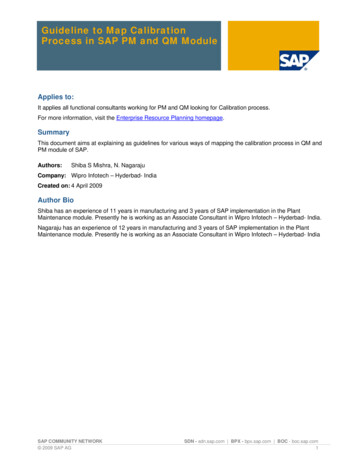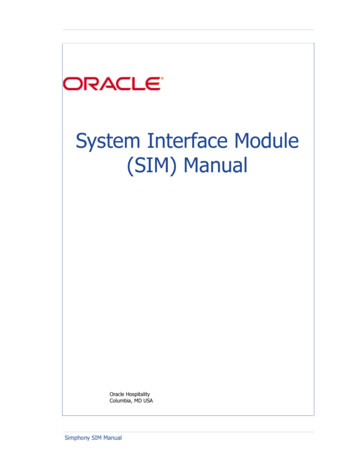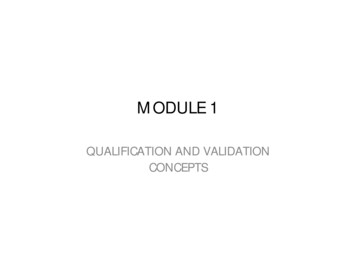
Transcription
MODULE 1QUALIFICATION AND VALIDATIONCONCEPTS
The objectives of this workshop1. Elevate our industry to more knowledge,2. better understanding of our manufacturing systems3. Focus on what’s important (Critical)4. More is not better5. Better technical understanding (Subject MatterExperts)
The objectives of this workshop1. Elevate our industry to more knowledge,2. better understanding of our manufacturing systems3. Focus on what’s important (Critical)4. More is not better5. Better technical understanding (Subject MatterExperts)
The objectives of this workshop1. Elevate our industry to more knowledge,2. better understanding of our manufacturing systems3. Focus on what’s important (Critical)4. More is not better5. Better technical understanding (Subject MatterExperts)
The objectives of this workshop1. Elevate our industry to more knowledge,2. better understanding of our manufacturing systems3. Focus on what’s important (Critical)4. More is not better5. Better technical understanding (Subject MatterExperts)
The objectives of this workshop1. Elevate our industry to more knowledge,2. better understanding of our manufacturing systems3. Focus on what’s important (Critical)4. More is not better5. Better technical understanding (Subject MatterExperts)
QUESTION :HOW CAN THE GROUPS HELP YOU INREACHING THESE OBJECTIVES ?
This workshop is not a how to do guide1. You should develop your appropriate systems andprocedures and not get “ready to use” procedures.2. You should develop tools and templates.GOOD NEWS : A LOT OF ANSWERSARE ALREADY IN .
This workshop is not a how to do guide1. You should develop your appropriate systems andprocedures and not get ready to use procedures.2. You should develop tools and templates.GOOD NEWS : A LOT OF ANSWERSARE ALREADY IN .ICHQ10
The beauty of ICH Q101. Where to go2. How to go3. Enablers.4. Risk assessment
The International Conference on Harmonisation of Technical Requirements forRegistration of Pharmaceuticals for Human Use (ICH) is unique in bringing together theregulatory authorities and pharmaceutical industry to discuss scientific and technicalaspects of drug registration. Since its inception in 1990, ICH has gradually evolved, torespond to the increasingly global face of drug development, so that the benefits ofinternational harmonisation for better global health can be realised worldwide. ICH'smission is to achieve greater harmonisation to ensure that safe, effective, and highquality medicines are developed and registered in the most resource-efficient manner
InnovationContinuous improvementICH Q10ISOGMPICH Q8PharmaceuticaldevelopmentManagement responsibilities.LifecycleIch Q 9Quality riskmanagement
Regulatory inspectionAt manufacturing siteICH Q10ISOGMPICH Q8Ich Q 9
Drug substance development.Formulation development.Manufacture of investigational products.Delivery system development.Manufacturing process development and scale upAnalythical method development.
New product transfers during development through manufacturing. Transfers within or betwinn manufacturing and testing sites for marketed products.
Acquisition and control of materialsProvision of facilities, utilities and equipmentProductionQuality control and assurance.ReleaseStorageDistribution.
Retention of documentation Sample retention Continued product assessment and reporting
ICH Q10 OBJECTIVES
anufacturingSystemsValidationLabSystemsHOW QMS INTERFERES WITHPRODUCT LIFE CYCLE ntionFacility& UtilitiesCalibrationComplaints
WHAT DO WE HAVE TO REMEMBER ?
ASTM E2500REMEMBER THE KEY CONCEPTS :1. RISK BASED APPROACH.2. SCIENCE BASED APPROACH.3. CRITICAL ASPECTS OF MANUFACTURING SYSTEMS4. QUALITY BY DESIGN5. GOOD ENGINEERING PRACTICES6. SUBJECT MATTER EXPERT7. USE OF VENDOR DOCUMENTATION8. CONTINUOUS PROCESS IMPROVEMENTQ8Q9
ASTM E2500REMEMBER THE KEY CONCEPTS :1 RISK BASED APPROACH.Q8APPLIED APPROPRIATELY AT EACH STAGEBASED ON SCIENTIFIC KNOWLEDGEPROTECTION OF THE PATIENTQ9
ASTM E2500REMEMBER THE KEY CONCEPTS :2SCIENCE BASED APPROACH.CONSIDERQ8Q9CRITICAL QUALITY ATTRIBUTESCQACRITICAL PROCESS PARAMETERSCPK
2SCIENCE BASED APPROACH.CRITICAL QUALITY ATTRIBUTES CQAProcess and equipment capability:CPK
2SCIENCE BASED APPROACH.Use ofstatisticsCRITICAL QUALITY ATTRIBUTES CQAProcess and equipment capability:CPKIn process improvement efforts, the processcapability index or process capability ratio is astatistical measure of process capability: theability of a process to produce output withinspecification limits.Wikipedia
2SCIENCE BASED APPROACH.Use ofstatisticsENABLERWikipedia
ASTM E2500REMEMBER THE KEY CONCEPTS :2SCIENCE BASED APPROACH.CONSIDERCRITICAL PROCESS PARAMETERSQ8Q9CPP
ASTM E2500REMEMBER THE KEY CONCEPTS :2SCIENCE BASED APPROACH.CONSIDERCRITICAL PROCESS PARAMETERSQ8Q9CPPSTATISTICAL TRENDINGIN « BEST IN CLASS » IT IS NOT SUFFICIENT TO DEMONSTRATE THATTHE SYSTEM IS UNDER CONTROL « WITHIN ITS CRITICAL PARAMETERSINFLUENCING THE CRITICAL QUALITY ATTRIBUTES » BUT IT IS GOODPRACTICE TO MONITOR THE STATISTICAL TRENDING.IS MY PROCESS DRIFTING ?
ASTM E2500REMEMBER THE KEY CONCEPTS :2SCIENCE BASED APPROACH.Q8Q9AGAIN : SCIENCE AND STATISTICS ARE ENABLERS TO HELP YOUCONTROLLING AND PREDICTING YOUR PROCESSENABLER
ASTM E2500REMEMBER THE KEY CONCEPTS :3Q8CRITICAL ASPECTS OF MANUFACTURING SYSTEMSQ9VERIFICATION ACTIVITIES SHOULD FOCUS ON THESE ASPECTS AND SHOULDBE DOCUMENTED
ASTM E2500REMEMBER THE KEY CONCEPTS :Q84Q9QUALITY BY DESIGNCRITICAL ASPECTS ARE DESIGNED INTO SYSTEMS DURING THESPECIFICATIONS AND DESIGN PROCESS. ASSOCIATED WITH ACCEPTANCE CRITERIAASSURANCE THAT MANUFACTURING SYSTEMS ARE FIT FOR INTENDED USE SHOULD NOTRELY SOLELY UPON VERIFICATION AFTER INSTALLATION BUT BE ACHIEVED BY A PLANNEDAND STRUCTURED VERIFICATION APPROACH APPLIED THROUGHOUT THE SYSTEM LIFECYCLE;
ASTM E2500REMEMBER THE KEY CONCEPTS :5GOOD ENGINEERING PRACTICESQ8Q9ESTABLISHED ENGINEERING METHODS AND STANDARDS THAT ARE APPLIEDTHROUGHOUT THE LIFE CYCLE TO DELIVER APPROPRIATE AND EFFECTIVESOLUTIONS
ASTM E2500REMEMBER THE KEY CONCEPTS :6SUBJECT MATTER EXPERTQ8INDIVIDUALS WITH SPECIFIC EXPERTISE AND RESPONSIBILITY IN APARTICULAR AREA OR FIELD :-ENGINEERINGQUALITYAUTOMATIONOPERATIONS.Q9
ASTM E2500REMEMBER THE KEY CONCEPTS :7USE OF VENDOR DOCUMENTATIONQ8Q9VENDOR DOCUMENTATION INCLUDING TEST DOCUMENTS MAY BE USED AS PARTOF THE VERIFICATION DOCUMENTATION PROVIDING THE REGULATED COMPANYHAS ASSESSED THE VENDOR AND HAS EVIDENCE OF :ACCEPTABLE VENDOR QUALITY SYSTEMVENDOR TECHNICAL CAPABILITYVENDOR APPLICATION OF GEP
ASTM E2500REMEMBER THE KEY CONCEPTS :8CONTINUOUS PROCESS IMPROVEMENTQ8Q9OPORTUNITY FOR IMPROVEMENT SHOULD BE SOUGHT BASED ON PERIODICREVIEW AND EVALUATION, OPERATIONAL AND PERFORMANCE DATA, ANDROOT-CAUSE ANALYSIS OF FAILURE.CHANGE MANAGEMENT SHOULD PROVIDE A DEPENDABLE MECHANISM FORPROMPT IMPLEMENTATION.
ROOT-CAUSE ANALYSIS OF FAILUREDO YOU MAKE ROOT CAUSE ANALYSISOF FAILURE ?
TRICK – FOR ROUTE CAUSE ANALYSIS OF FAILURETHE 6 WHY
EX : WE FAILED A MEDIA FILLWHY 1 : BECAUSE WE HAD A POLLUTION ON A FILLING NEEDLEWHY 2 : BECAUSE WE HAD A BAD STEAM STERILIZATIONWHY 3 : BECAUSE THE STEAM FLOW WAS NOT BALANCED PROPERLYWHY 4 : BECAUSE WE CHANGED A NEEDLE BEFORE THE STERILIZATIONWHY 5 : BECAUSE THE NEW NEEDLE WAS SLIGHTHY DIFFERENTWHY 6 : BECAUSE THE NEEDLE DRAWING WAS NOT CORRECT
Objective oneACHIEVE PRODUCT REALISATIONTo establish, implement and maintain asystem that allows the delivery of productsWith the quality attributes appropriate tomeet the needs of patients, health careprofessionals, regulatory authorities andother internal or external customers.
Objective twoESTABLISH AND MAINTAIN A STATE OF CONTROLTo develop and use effective monitoringand control systems for processperformance and product quality, therebyproviding assurance of continued suitabilityand capability of processes.Quality risk management can be useful inidentifying the monitoring and controlsystems.
Objective twoESTABLISH AND MAINTAIN A STATE OF CONTROLTo develop and use effective monitoringand control systems for processENABLERperformance and product quality, therebyproviding assurance of continued suitabilityand capability of processes.Quality risk management can be useful inidentifying the monitoring and controlsystems.
ENABLER :A tool or process which provides the meansto achieve an objective
ENABLER :A tool or process which provides the meansto achieve an objective
ENABLER :A tool or process which provides the meansto achieve an objectiveCan you list 5 toolswhich are enablers inYour daily activities ?
ENABLER :A tool or process which provides the meansto achieve an objectiveFMEASUBJECT MATTER EXPERTS
ENABLER :A tool or process which provides the meansto achieve an objective
ENABLER :A tool or process which provides the meansto achieve an objectiveCan you list 5 processeswhich are enablers inYour daily activities ?
ENABLER :A tool or process which provides the meansto achieve an objectiveValidation plans.Procedures.
Objective threeFACILITATE CONTINUAL IMPROVEMENTTo identify and implement product qualityimprovements, process improvements,variability reduction, innovations andpharmaceutical quality systemenhancement, thereby increasing theability to fulfil quality needs consistently.
Objective threeFACILITATE CONTINUAL IMPROVEMENTTo identify and implement product qualityimprovements, process improvements,variability reduction, innovations andpharmaceutical quality systemenhancement, thereby increasing theability to fulfil quality needs consistently.
Objective threeFACILITATE CONTINUAL IMPROVEMENTTo identify and implement product qualityimprovements, process improvements,variability reduction, innovations andpharmaceutical quality systemenhancement, thereby increasing theability to fulfil quality needs consistently.
Objective threeFACILITATE CONTINUAL IMPROVEMENTTo identify and implement product qualityimprovements, process improvements,variability reduction, innovations andpharmaceutical quality systemenhancement, thereby increasing theability to fulfil quality needs consistently.
Objective threeFACILITATE CONTINUAL IMPROVEMENTTo identify and implement product qualityimprovements, process improvements,variability reduction, innovations andpharmaceutical quality systemenhancement, thereby increasing theability to fulfil quality needs consistently.
Objective threeFACILITATE CONTINUAL IMPROVEMENTTo identify . consistently.Quality risk management can be useful foridentifying and prioritising areas forcontinual improvement.
Objective threeFACILITATE CONTINUAL IMPROVEMENTTo identify . consistently.Quality risk management can be useful forHow can Quality Riskidentifying and prioritising areas forManagementhelpincontinual improvement.identifying andprioritising continualimprovement ?
Knowledge management ON RELATEDTO PRODUCTS
Knowledge managementINFORMATION RELATEDTO PRODUCTS Public domain.Pharmaceutical development studies.Technology transfer activities.Process validation studies.Manufacturing experience.Innovation.Continual improvementChange management
How is my companyorganized to acquire,analyse, store anddissiminate knowledge ?
Knowledge management Public domain. Pharmaceutical developmentstudies. Technology transfer activities. Process validation studies. Manufacturing experience. Innovation. Continual improvement Change management Regulatory affairs. R&D Technical support dptTechnical support dptManufacturing dptR&DQuality dptQuality dpt
Quality risk managementProvide a proactive approach to identifying,scientifically evaluating and controllingpotential risks to quality.ICH Q9
‚ƒ„Risk Management must be integrated intothe Quality Management Systems
Quality risk management –What to rememberWhat toremember ?1. Minimum essentials5. Risk-Based procedures2. Manageable approach6. Incremental risk assessments3. One Size. . .7. Into current processes4. Risk & requirements8. Of little value if . . .
Take away-Identify problemsEvaluate causesEstimate consequencesDefine & implement safeguards
Quality risk management –What to remember1. Minimum essentials5. Risk-Based procedures2. Manageable approach6. Incremental risk assessments3. One Size. . .7. Into current processes4. Risk & requirements8. Of little value if . . .What not to do ?
It is not a one person activity.The team must have a good knowledge :Involve the subject matter experts.If it is not followed by MITIGATION strategy supportedby management it is a waste of energy.It must be implemented, verified and followed by aresponsible person reporting to management.It must follow a PDCA rule.
NOT TO DODo not push Risk Management beyondcommon sense you must- Definean approach that is maintainable- Scale the effort based oncriticality and complexity
DESIGNYESQUALIFICATIONVALIDATIONDIRECT IMPACT ?NOCOMMISSIONING
DIRECT IMPACT ?73
How to determine that a system has a directimpact and therefore is Critical ?Can you write down 5 questions to determine ifthe system has a direct impact ?Example : Is the system in contact with the product?(syringe)7415 minutes
Y1N2NYY3NY4NY5N6YNY7INDIRECTDIRECT
The table before is the rationale to explain why a processparameters has been identified as non-critical. A non critical parameter is also called a « generalparameter »REMEMBER
DESIGN1. IN LINE WITH URS2. WILL DRIVE THE FUNCTIONAL SPECIFICATIONS.3. WILL DEFINE THE OPERATIONAL RANGE4. WILL DEFINE THE EXPECTED PERFORMANCES.5. WILL INCLUDE THE RISK ASSESSMENT.6. WILL INCLUDE THE MITIGATION OUTPUTS.7. WILL INCLUDE THE STANDARDS.8. WILL INCLUD
astm e2500 q8 q9 vendor documentation including test documents may be used as part of the verification documentation providing the regulated company has assessed the vendor and has evidence of : acceptable vendor quality system vendor technical capability vendor application of gep. remember the key concepts : 8 continuous process improvement astm e2500 q8 q9 oportunity for improvement


